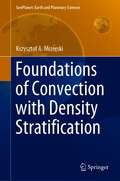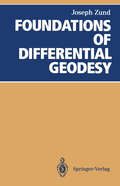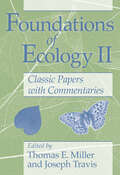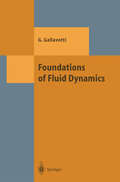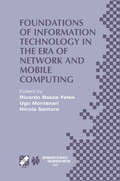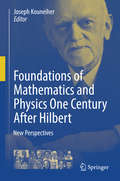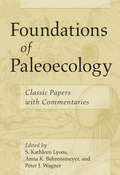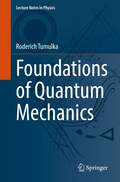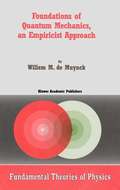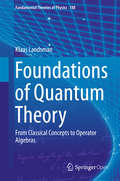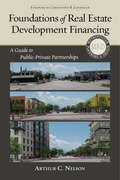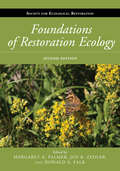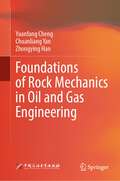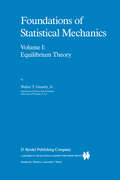- Table View
- List View
Foundations of Classical Electrodynamics: Charge, Flux, and Metric (Progress in Mathematical Physics #33)
by Friedrich W Hehl Yuri N. ObukhovIn this book we display the fundamental structure underlying classical electro dynamics, i. e. , the phenomenological theory of electric and magnetic effects. The book can be used as a textbook for an advanced course in theoretical electrodynamics for physics and mathematics students and, perhaps, for some highly motivated electrical engineering students. We expect from our readers that they know elementary electrodynamics in the conventional (1 + 3)-dimensional form including Maxwell's equations. More over, they should be familiar with linear algebra and elementary analysis, in cluding vector analysis. Some knowledge of differential geometry would help. Our approach rests on the metric-free integral formulation of the conservation laws of electrodynamics in the tradition of F. Kottler (1922), E. Cartan (1923), and D. van Dantzig (1934), and we stress, in particular, the axiomatic point of view. In this manner we are led to an understanding of why the Maxwell equa tions have their specific form. We hope that our book can be seen in the classical tradition of the book by E. J. Post (1962) on the Formal Structure of Electro magnetics and of the chapter "Charge and Magnetic Flux" of the encyclopedia article on classical field theories by C. Truesdell and R. A. Toupin (1960), in cluding R. A. Toupin's Bressanone lectures (1965); for the exact references see the end of the introduction on page 11. .
Foundations of Convection with Density Stratification (GeoPlanet: Earth and Planetary Sciences)
by Krzysztof A. MizerskiThis book continues the process of systematization of knowledge about convection. It is important to put the current knowledge on weakly and strongly stratified convection in order, and provide a comprehensive description of the marginal, weakly nonlinear and fully developed stages of convective flow in both cases. The book provides a short compendium of knowledge on the linear and weakly nonlinear limits of the Boussinesq convection, and a review of the theory on fully developed Boussinesq convection. The third chapter is devoted to a detailed derivation and a study of the three aforementioned stages of stratified (anelastic) convection, with a full solution in the marginal stage provided for the first time. Detailed and systematic explanations are given. The book is intended mainly as a textbook for courses on hydrodynamics and convective flows, for the use of lecturers and students; however, it also serves for the entire scientific community as a practical reference.
Foundations of Differential Geodesy
by Joseph ZundDifferential geodesy is concerned with the geometry of the gravity field of the Earth, which is of fundamental importance to both theoretical geodesy and geophysics. This monograph presents a unified treatment of the foundations of differential geodesy as proposed originally by Antonio Marussi and Martin Hotine in their work. The principal features of the Marussi-Hotine approach to theoretical aspects are given in the first five chapters (based on leg calculus), while the last five chapters are devoted to the fundamental ideas of the Marussi and Hotine theory. The text includes practical problems and is intended for use by research geodesists, graduate students in geodesy, and theoretical geophysicists.
Foundations of Ecology II: Classic Papers with Commentaries
The classic papers that laid the foundations of modern ecology alongside commentaries by noted ecologists. The period of 1970 to 1995 was a time of tremendous change in all areas of ecology—from an increased rigor for experimental design and analysis to the reevaluation of paradigms, new models for understanding, and theoretical advances. Edited by ecologists Thomas E. Miller and Joseph Travis, Foundations of Ecology II includes facsimiles of forty-six papers from this period alongside expert commentaries that discuss a total of fifty-three key studies, addressing topics of diversity, predation, complexity, competition, coexistence, extinction, productivity, resources, distribution, abundance, and conservation. The result is more than a catalog of historic firsts; this book offers diverse perspectives on the foundational papers that led to today’s ecological work. Like this book’s 1991 predecessor, Foundations of Ecology edited by Leslie A. Real and James H. Brown, Foundations of Ecology II promises to be the essential primer for graduate students and practicing ecologists for decades to come.
Foundations of Engineering Geology
by Tony WalthamNow in full colour, the third edition of this well established book provides a readable and highly illustrated overview of the aspects of geology that are most significant to civil engineers. Sections in the book include those devoted to the main rock types, weathering, ground investigation, rock mass strength, failures of old mines, subsidence on peats and clays, sinkholes on limestone and chalk, water in landslides, slope stabilization and understanding ground conditions. The roles of both natural and man-induced processes are assessed, and this understanding is developed into an appreciation of the geological environments potentially hazardous to civil engineering and construction projects. For each style of difficult ground, available techniques of site investigation and remediation are reviewed and evaluated. Each topic is presented as a double page spread with a careful mix of text and diagrams, with tabulated reference material on parameters such as bearing strength of soils and rocks. This new edition has been comprehensively updated and covers the entire spectrum of topics of interest for both students and practitioners in the field of civil engineering.
Foundations of Engineering Geology
by Tony Waltham A.C. WalthamNow in full colour, the third edition of this well established book provides a readable and highly illustrated overview of the aspects of geology that are most significant to civil engineers.Sections in the book include those devoted to the main rock types, weathering, ground investigation, rock mass strength, failures of old mines, subsidence on peats and clays, sinkholes on limestone and chalk, water in landslides, slope stabilization and understanding ground conditions. The roles of both natural and man-induced processes are assessed, and this understanding is developed into an appreciation of the geological environments potentially hazardous to civil engineering and construction projects. For each style of difficult ground, available techniques of site investigation and remediation are reviewed and evaluated.Each topic is presented as a double page spread with a careful mix of text and diagrams, with tabulated reference material on parameters such as bearing strength of soils and rocks. This new edition has been comprehensively updated and covers the entire spectrum of topics of interest for both students and practitioners in the field of civil engineering.
Foundations of Engineering Geology
by Tony Waltham A.C. WalthamNow in full colour, the third edition of this well established book provides a readable and highly illustrated overview of the aspects of geology that are most significant to civil engineers.Sections in the book include those devoted to the main rock types, weathering, ground investigation, rock mass strength, failures of old mines, subsidence on peats and clays, sinkholes on limestone and chalk, water in landslides, slope stabilization and understanding ground conditions. The roles of both natural and man-induced processes are assessed, and this understanding is developed into an appreciation of the geological environments potentially hazardous to civil engineering and construction projects. For each style of difficult ground, available techniques of site investigation and remediation are reviewed and evaluated.Each topic is presented as a double page spread with a careful mix of text and diagrams, with tabulated reference material on parameters such as bearing strength of soils and rocks. This new edition has been comprehensively updated and covers the entire spectrum of topics of interest for both students and practitioners in the field of civil engineering.
Foundations of Environmental Economics (Springer Texts in Business and Economics)
by Wolfgang Buchholz Dirk RübbelkeThis textbook provides a solid introduction to the theoretical and empirical aspects of environmental economics, and their links to environmental policy. It advocates drawing on the economist’s toolbox as a powerful means of finding solutions to environmental problems by addressing the conflict between the societal costs of pollution on the one hand, and the financial costs of emissions reduction on the other. The book presents the main economic theory approaches to handling environmental problems and assessing the monetary value of environmental quality; the most relevant environmental policy instruments and challenges involved in their effective real-world application; and both national and global environmental problems addressed by environmental negotiations and agreements. Given its scope, the book offers a valuable basis of information for students, and for policymakers pursuing effective environmental policies.
Foundations of Fluid Dynamics (Theoretical and Mathematical Physics)
by Giovanni GallavottiThis monograph on fluid mechanics is not only a superb and unique textbook but also an impressive piece of research. It is the only textbook that fully covers turbulence, all the way from the works of Kolmogorov to modern dynamics.
Foundations of Information Technology in the Era of Network and Mobile Computing: IFIP 17th World Computer Congress — TC1 Stream / 2nd IFIP International Conference on Theoretical Computer Science (TCS 2002) August 25–30, 2002, Montréal, Québec, Canada (IFIP Advances in Information and Communication Technology #96)
by Ricardo Baeza-Yates Ugo Montanari Nicola SantoroFoundations of Information Technology in the Era of Network and Mobile Computing is presented in two distinct but interrelated tracks: -Algorithms, Complexity and Models of Computation; -Logic, Semantics, Specification and Verification.This volume contains 45 original and significant contributions addressing these foundational questions, as well as 4 papers by outstanding invited speakers. These papers were presented at the 2nd IFIP International Conference on Theoretical Computer Science (TCS 2002), which was held in conjunction with the 17th World Computer Congress, sponsored by the International Federation for Information Processing (IFIP), and which convened in Montréal, Québec, Canada in August 2002.
Foundations of Mathematics and Physics One Century After Hilbert: New Perspectives
by Joseph KouneiherThis book explores the rich and deep interplay between mathematics and physics one century after David Hilbert’s works from 1891 to 1933, published by Springer in six volumes. The most prominent scientists in various domains of these disciplines contribute to this volume providing insight to their works, and analyzing the impact of the breakthrough and the perspectives of their own contributions. The result is a broad journey through the most recent developments in mathematical physics, such as string theory, quantum gravity, noncommutative geometry, twistor theory, Gauge and Quantum fields theories, just to mention a few. The reader, accompanied on this journey by some of the fathers of these theories, explores some far reaching interfaces where mathematics and theoretical physics interact profoundly and gets a broad and deep understanding of subjects which are at the core of recent developments in mathematical physics. The journey is not confined to the present state of the art, but sheds light on future developments of the field, highlighting a list of open problems. Graduate students and researchers working in physics, mathematics and mathematical physics will find this journey extremely fascinating. All those who want to benefit from a comprehensive description of all the latest advances in mathematics and mathematical physics, will find this book very useful too.
Foundations of Paleoecology: Classic Papers with Commentaries
by Kathleen Lyons Anna K. Behrensmeyer Peter WagnerApproximately 99% of all life that has ever existed is extinct. Fortunately, these long dead species have left traces of their lives and interactions with other species in the rock record that paleoecologists use to understand how species and ecosystems have changed over time. This record of past life allows us to study the dynamic nature of the Earth and gives context to current and future ecological challenges. This book brings together forty-four classic papers published between 1924 and 1999 that trace the origins and development of paleoecology. The articles cross taxonomic groups, habitat types, geographic areas, and time and have made substantial contributions to our knowledge of the evolution of life. Encompassing the full breadth of paleoecology, the book is divided into six parts: community and ecosystem dynamics, community reconstruction, diversity dynamics, paleoenvironmental reconstruction, species interaction, and taphonomy. Each paper is also introduced by a contemporary expert who gives context and explains its importance to ongoing paleoecological research. A comprehensive introduction to the field, Foundations of Paleoecology will be an essential reference for new students and established paleoecologists alike.
Foundations of Paleoecology: Classic Papers with Commentaries
by Kathleen Lyons Anna K. Behrensmeyer Peter WagnerApproximately 99% of all life that has ever existed is extinct. Fortunately, these long dead species have left traces of their lives and interactions with other species in the rock record that paleoecologists use to understand how species and ecosystems have changed over time. This record of past life allows us to study the dynamic nature of the Earth and gives context to current and future ecological challenges. This book brings together forty-four classic papers published between 1924 and 1999 that trace the origins and development of paleoecology. The articles cross taxonomic groups, habitat types, geographic areas, and time and have made substantial contributions to our knowledge of the evolution of life. Encompassing the full breadth of paleoecology, the book is divided into six parts: community and ecosystem dynamics, community reconstruction, diversity dynamics, paleoenvironmental reconstruction, species interaction, and taphonomy. Each paper is also introduced by a contemporary expert who gives context and explains its importance to ongoing paleoecological research. A comprehensive introduction to the field, Foundations of Paleoecology will be an essential reference for new students and established paleoecologists alike.
Foundations of Paleoecology: Classic Papers with Commentaries
Approximately 99% of all life that has ever existed is extinct. Fortunately, these long dead species have left traces of their lives and interactions with other species in the rock record that paleoecologists use to understand how species and ecosystems have changed over time. This record of past life allows us to study the dynamic nature of the Earth and gives context to current and future ecological challenges. This book brings together forty-four classic papers published between 1924 and 1999 that trace the origins and development of paleoecology. The articles cross taxonomic groups, habitat types, geographic areas, and time and have made substantial contributions to our knowledge of the evolution of life. Encompassing the full breadth of paleoecology, the book is divided into six parts: community and ecosystem dynamics, community reconstruction, diversity dynamics, paleoenvironmental reconstruction, species interaction, and taphonomy. Each paper is also introduced by a contemporary expert who gives context and explains its importance to ongoing paleoecological research. A comprehensive introduction to the field, Foundations of Paleoecology will be an essential reference for new students and established paleoecologists alike.
Foundations of Potential Theory (Grundlehren der mathematischen Wissenschaften #31)
by Oliver Dimon KelloggThe present volume gives a systematic treatment of potential functions. It takes its origin in two courses, one elementary and one advanced, which the author has given at intervals during the last ten years, and has a two-fold purpose: first, to serve as an introduction for students whose attainments in the Calculus include some knowledge of partial derivatives and multiple and line integrals; and secondly, to provide the reader with the fundamentals of the subject, so that he may proceed immediately to the applications, or to the periodical literature of the day. It is inherent in the nature of the subject that physical intuition and illustration be appealed to freely, and this has been done. However, that the book may present sound ideals to the student, and in order also serve the mathematician, both for purposes of reference and as a basis for further developments, the proofs have been given by rigorous methods. This has led, at a number of points, to results either not found elsewhere, or not readily accessible. Thus, Chapter IV contains a proof for the general regular region of the divergence theorem (Gauss', or Green's theorem) on the reduction of volume to surface integrals. The treatment of the fundamental existence theorems in Chapter XI by means of integral equations meets squarely the difficulties incident to ·the discontinuity of the kernel, and the same chapter gives an account of the most recent developments with respect to the Dirichlet problem.
Foundations of Quantum Mechanics (Lecture Notes in Physics #1003)
by Roderich TumulkaThis book introduces and critically appraises the main proposals for how to understand quantum mechanics, namely the Copenhagen interpretation, spontaneous collapse, Bohmian mechanics, many-worlds, and others. The author makes clear what are the crucial problems, such as the measurement problem, related to the foundations of quantum mechanics and explains the key arguments like the Einstein-Podolsky-Rosen argument and Bell’s proof of nonlocality. He discusses and clarifies numerous topics that have puzzled the founding fathers of quantum mechanics and present-day students alike, such as the possibility of hidden variables, the collapse of the wave function, time-of-arrival measurements, explanations of the symmetrization postulate for identical particles, or the nature of spin. Several chapters are devoted to extending the different approaches to relativistic space-time and quantum field theory. The book is self-contained and is intended for graduate students and researchers who want to step into the fundamental aspects of quantum physics. Given its clarity, it is accessible also to advanced undergraduates and contains many exercises and examples to master the subject.
Foundations of Quantum Mechanics, an Empiricist Approach (Fundamental Theories of Physics #127)
by W.M. de MuynckTaking a new perspective provided by a generalization of the mathematical formalism encompassing positive operator-valued measures, this book views old and new problems of the foundations of quantum mechanics. It demonstrates the crucial role of the generalized formalism in fundamental issues and practical applications.
Foundations of Quantum Theory: From Classical Concepts to Operator Algebras (Fundamental Theories of Physics #188)
by Klaas LandsmanThis book studies the foundations of quantum theory through its relationship to classical physics. This idea goes back to the Copenhagen Interpretation (in the original version due to Bohr and Heisenberg), which the author relates to the mathematical formalism of operator algebras originally created by von Neumann. The book therefore includes comprehensive appendices on functional analysis and C*-algebras, as well as a briefer one on logic, category theory, and topos theory. Matters of foundational as well as mathematical interest that are covered in detail include symmetry (and its "spontaneous" breaking), the measurement problem, the Kochen-Specker, Free Will, and Bell Theorems, the Kadison-Singer conjecture, quantization, indistinguishable particles, the quantum theory of large systems, and quantum logic, the latter in connection with the topos approach to quantum theory.This book is Open Access under a CC BY licence.
Foundations of Real Estate Development Financing: A Guide to Public-Private Partnerships (Metropolitan Planning + Design Ser.)
by Arhur C. NelsonAmerican’s landscape is undergoing a profound transformation as demand grows for a different kind of American Dream--smaller homes on smaller lots, multifamily options, and walkable neighborhoods. This trend presents a tremendous opportunity to reinvent our urban and suburban areas. But in a time of fiscal austerity, how do we finance redevelopment needs? In Foundations of Real Estate Development Finance: A Guide for Public-Private Partnerships, urban scholar Arthur C. Nelson argues that efficient redevelopment depends on the ability to leverage resources through partnerships. Public-private partnerships are increasingly important in reducing the complexity and lowering the risk of redevelopment projects. Although planners are in integral part of creating these partneships, their training does generally not include real-estate finacing, which presents challenges and imbalances in public-private partnership.This is the first primer on financing urban redevelopment written for practicing planners and public administrators. In easy-to-understand language, it will inform readers of the natural cycle of urban development, explain how to overcome barriers to efficient redevelopment, what it takes for the private sector to justify its redevelopment investments, and the role of public and nonprofit sectors to leverage private sector redevelopment where the market does not generate sufficient rates of return.This is a must read for practicing planners and planning students, economic development officials, public administrators, and others who need to understand how to leverage public and non-profit resources to leverage private funds for redevelopment.
Foundations of Restoration Ecology (The\science And Practice Of Ecological Restoration Ser.)
by Margaret A. Palmer, Joy B. Zedler and Donald A. FalkThis second edition provides the latest emerging theories and ideas in the science of restoration ecology. Fully one-third longer than the first edition and comprehensive in scope, it has been dramatically updated to reflect new research. Included are new sections devoted to concepts critical to all restoration projects as well as restoration of specific ecosystem processes, including hydrology, nutrient dynamics, and carbon. Also new to this edition are case studies that describe real-life restoration scenarios in North and South America, Europe, and Australia. They highlight supporting theory for restoration application and other details important for assessing the degree of success of restoration projects in a variety of contexts. Lists at the end of each chapter summarize new theory introduced in that chapter and its practical application.
Foundations of Rock Mechanics in Oil and Gas Engineering
by Yuanfang Cheng Chuanliang Yan Zhongying HanThis book introduces the basic theoretical knowledge of rock mechanics and its application in petroleum engineering. It covers the gamut of the formulas and calculations for petroleum engineers that have been compiled over decades, while others are meant to help guide the engineer through some of the more recent breakthroughs in the industry’s technology.The topics are introduced at a level that should give a good basic understanding of the subject:• Basic concepts of stress and strain• Experimental method of rock mechanics• Rock deformation and strength characteristics• Rock strength failure criterion• In situ stress state• Application method of rock mechanics theory in the field of wellbore stability• Application method of rock mechanics theory in the field of sand production• Application method of rock mechanics theory in the field of hydraulic fracturing.This textbook contains abundant figures, illustrations, and tables, providing valuable examples and exercises.Key Features and Benefits for the Reader: • Helps in understanding the basic concepts of rock mechanics• Applies rock mechanics theory and method to various fields of petroleum engineering• Includes a large number of calculations, tables, and equations that are very useful for petroleum engineers• Presents new and updated sections in rock mechanics of petroleum engineering.
Foundations of Social Entrepreneurship: Theory, Practical Tools and Skills
by Tanja CollavoFoundations of Social Entrepreneurship presents definitions of social entrepreneurship, explains its benefits and challenges, describes the components of an ecosystem of support, and presents practical tools to approach social entrepreneurial projects. It is designed to be easily approachable by anyone without prior in-depth knowledge of the subject. The book is divided into two parts; the first provides readers with theoretical foundations to understand the phenomenon of social entrepreneurship, its different interpretations, the context in which it developed, and its socio-economic function. The second part of the book covers what it takes to create and manage a social entrepreneurial initiative. Pedagogical features are incorporated throughout to aid learning. They include summary tables, international case studies of social entrepreneurs from both developed and emerging economies, as well as suggested exercises and examples of how the tools presented are used in practice. Truly global in its scope, with a strong emphasis on combining theory with practice, this text should be core reading for advanced undergraduate and postgraduate students studying Social Entrepreneurship, Enterprise, and Responsible Business. Online resources include links to resources, chapter-by-chapter PowerPoint slides and instructor's manual.
Foundations of Social Entrepreneurship: Theory, Practical Tools and Skills
by Tanja CollavoFoundations of Social Entrepreneurship presents definitions of social entrepreneurship, explains its benefits and challenges, describes the components of an ecosystem of support, and presents practical tools to approach social entrepreneurial projects. It is designed to be easily approachable by anyone without prior in-depth knowledge of the subject. The book is divided into two parts; the first provides readers with theoretical foundations to understand the phenomenon of social entrepreneurship, its different interpretations, the context in which it developed, and its socio-economic function. The second part of the book covers what it takes to create and manage a social entrepreneurial initiative. Pedagogical features are incorporated throughout to aid learning. They include summary tables, international case studies of social entrepreneurs from both developed and emerging economies, as well as suggested exercises and examples of how the tools presented are used in practice. Truly global in its scope, with a strong emphasis on combining theory with practice, this text should be core reading for advanced undergraduate and postgraduate students studying Social Entrepreneurship, Enterprise, and Responsible Business. Online resources include links to resources, chapter-by-chapter PowerPoint slides and instructor's manual.
Foundations of Statistical Mechanics: Equilibrium Theory (Fundamental Theories of Physics #19)
by W.T. Grandy Jr.In a certain sense this book has been twenty-five years in the writing, since I first struggled with the foundations of the subject as a graduate student. It has taken that long to develop a deep appreciation of what Gibbs was attempting to convey to us near the end of his life and to understand fully the same ideas as resurrected by E.T. Jaynes much later. Many classes of students were destined to help me sharpen these thoughts before I finally felt confident that, for me at least, the foundations of the subject had been clarified sufficiently. More than anything, this work strives to address the following questions: What is statistical mechanics? Why is this approach so extraordinarily effective in describing bulk matter in terms of its constituents? The response given here is in the form of a very definite point of view-the principle of maximum entropy (PME). There have been earlier attempts to approach the subject in this way, to be sure, reflected in the books by Tribus [Thermostat ics and Thermodynamics, Van Nostrand, 1961], Baierlein [Atoms and Information Theory, Freeman, 1971], and Hobson [Concepts in Statistical Mechanics, Gordon and Breach, 1971].
Foundations of Sustainable Business
by null Nada R. Sanders null John D. WoodAn insightful and easy-to-follow introduction to the defining business sustainability issues of our generation Describing sustainable business from the perspective of management, Nada R. Sanders and John D. Wood explain how and why increased consumer and regulatory pressure for sustainable performance is driving changes in core business functions, legal frameworks, metrics, reporting, and more. Clear and accessible chapters offer comprehensive, well-balanced coverage of key concepts in social, economic, and environmental sustainability, supported by original case studies, real-world examples, practice quizzes, and other learning tools. Now in its third edition, Foundations of Sustainable Business; Theory, Function, and Strategy provides a thorough introduction to the social and environmental issues defining contemporary markets and societies. Designed to prepare aspiring business leaders to tackle urgent problems with a direct impact on their firms’ bottom lines, this respected textbook employs a qualitative learning process that walks students through the application of sustainability concepts to leadership, finance, accounting, risk management, marketing, supply chain management, and operations. Written by a business thought-leader and a public interest policy expert, Foundations of Sustainable Business: Theory, Function, and Strategy, Third Edition is an excellent primary or supplementary textbook for undergraduate and graduate courses in business administration, management, and marketing. It is also an invaluable resource for business leaders looking for an intuitive and incisive introduction to sustainability concepts relevant to modern professionals, managers, and executives.

